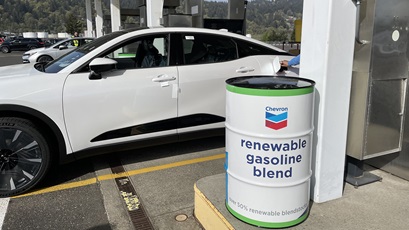alternative fuels
working for peanuts: collaboration aims to increase renewables, help farmers
1 min read | august 02, 2022
Did you know that peanuts helped revolutionize the transportation sector? Rudolf Diesel unveiled the world’s first diesel engine—fueled by peanut oil—at the Paris Exposition in 1900. More than a century later, the “diesel nut” is poised to be pivotal as the energy industry works to bring about a lower carbon future.
in a nutshell
Chevron is working with Texas A&M AgriLife to explore peanuts as a renewable fuel source. Our research includes the development of peanuts with a greater oil content that can adapt to drier climates.
“We are hopeful that these new peanut varieties will offer producers a profitable dryland or limited irrigation crop option,” said Cliff Lamb, director of Texas A&M AgriLife Research.
The collaboration will help create new economic opportunities for Texas farmers while supporting Chevron’s efforts to increase our renewable fuels production capacity to 100,000 barrels per day by 2030.
parched peanuts
Peanuts tend to be thirsty. A typical crop needs 27 inches of moisture from irrigation and rain to produce about 5,000 pounds per acre of high-quality nuts. AgriLife intends to breed a “diesel nut” that can be more easily quenched.
If successful, this project could bring production back to areas that previously grew peanuts but ran out of water.
more on that
Our collaboration with AgriLife seeks to:
- Help create a new revenue stream for farmers.
- Use otherwise non-productive farmland.
- Develop no-water, no-till practices that lower the carbon intensity of farming.
- Support Chevron’s university research programs.
what they’re saying
“The Texas Peanut Producers Board is excited to support the ‘diesel nut’ project and views it as one more tool for farmers in Texas,” said Shelly Nutt, Texas Peanut Producers Board executive director. “Peanut farmers have long realized the value of using peanuts not only as a cash crop, but also as a crop that adds nutrients to the soil, creating a sustainable production system.”
Approximately 20% of the nation’s peanut crop is produced in Texas, making it the second-largest peanut-producing state in the United States, according to AgriLife Research.
topics covered
related content
-

 novel ideas, established companies key to advancing lower carbon tech
novel ideas, established companies key to advancing lower carbon techemissions solutionsjanuary 14, 2025
-

 chevron CEO talks growing production, efficient spending
chevron CEO talks growing production, efficient spendingemissions solutionsdecember 18, 2024
-

 1st US hydrogen-powered passenger ferry open for business
1st US hydrogen-powered passenger ferry open for businessalternative fuelsaugust 23, 2024
-

 toyota and chevron drive progress with renewable gasoline blend
toyota and chevron drive progress with renewable gasoline blendalternative fuelsjuly 18, 2024
chevron email updates
Subscribe to our newsletter to receive news and updates.



